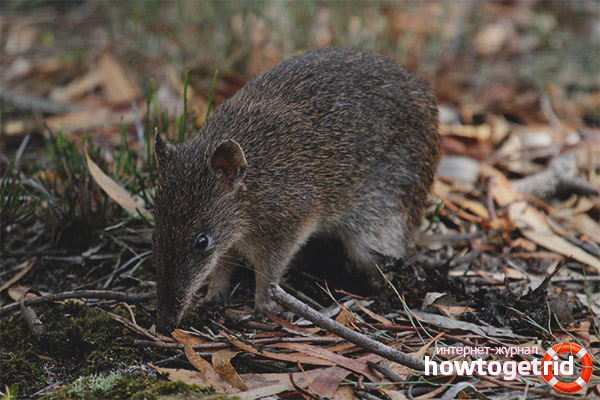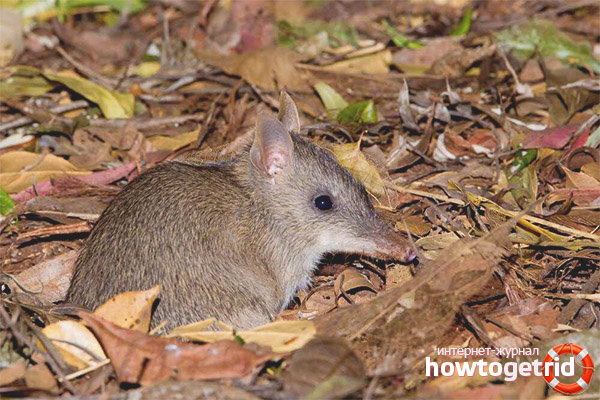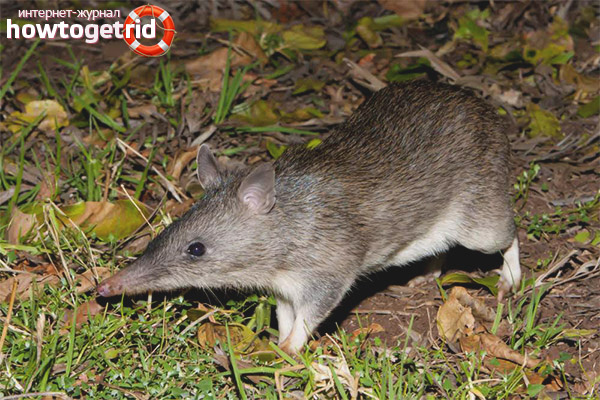The content of the article
Bandicuts are called marsupial badgers. These animals can be attributed to exotic species. They inhabit endemic Australian territories. The range of their distribution is associated with sufficient latitude, and some representatives live in an area whose height is 2000 m above sea level. Despite the wide habitat, today in Australia this animal is very rare and is on the verge of extinction.
general description
The marsupial badger is a small animal. Its body length is in the range from 17 to 50 cm. Animals weigh about 2 kg. The weight of individual large individuals can reach 5 kg. The dimensions of the males are slightly larger in comparison with the females.
External signs
It is not difficult to find a marsupial badger, and its specific external data will help in this:
- The animal has a pointed muzzle, which is extremely similar to a rat. As for the body, it resembles a rabbit. The animal has a compact body with rather long legs. They are more developed at the back and are very powerful.
- The muzzle has relatively small eyes, which have good sensitivity to daylight.
- There is no hair on the ears, and their shape is determined by the appearance. They can be round or pointed.
- The forelimbs are equipped with long fingers. Claws are located on them, but on the first and fifth fingers they are absent.
- The hind limbs are devoid of the first finger. The second finger fuses with the third (syndactyly), but the claws on them are separate. In this they differ from other marsupials. Fused fingers with separate claws form a kind of scallop, with the help of which the animal combs its hair.
- There is wool on the tail, and it has a short length.
- In the lower part of the body is a bag that opens back.
- The nature of the coat is determined by the species. In some, it is soft and long, while others have short and hard hair.
- In the color there is a dark gray or brown gamut of colors. Dark transverse stripes are located in the sacral region.
- In Australia, there is even a coin in circulation with a picture of a marsupial badger on the reverse. She appeared in circulation in 2011.
Lifestyle properties
Life expectancy is not more than two years. Only individual specimens manage to reach the age of three. If you place the animal in captivity, then you can tame it pretty well. At home, with proper maintenance, it may well live 4 years.
According to the classification, the Bandicoot squad consists of three families. In turn, they are divided into subfamilies, and those into genera, which include various species.
Habitat
The entire territory of Australia, as well as the island of Tasmania are the habitat of long-nosed and short-nosed bandicoots. They are very comfortable in this area. For them, woodland where dense vegetation is present is preferable.But they can also be located in open areas near villages.
Spiky bandicoots are found only in Papua New Guinea. They like to settle in places with rugged mountain vegetation. The New Guinean bandicoots are characterized by presence in certain territories of the island of New Guinea and Yapen. They can be found where high in the mountains there are dense shrubs and grass.
Vocalization Properties
This animal is not capable of making loud sounds. But the bandicut snaps its teeth perfectly. In this way, he tries to scare and stop his enemy. Long-nosed bandicoots may signal a danger. It is creaking in nature. If the animal is woken up in the middle of the night, it begins to sneeze intensely. In this way, the bandicoot tries to clear the nose of the land that has got into it.
Bandicut Diet Character
These representatives of the fauna belong to omnivorous animals. Their fangs are small, but have quite significant strength. Thanks to this, they can easily cope with prey if they come across a lizard or small rodents. If they do not meet on the way of the bandicoot, he would not mind to enjoy other foods that are less attractive. It can be worms, snails, termites, larvae of various insects.
In addition, the animal's diet contains fruits and eggs of birds, roots and seeds of plants. But the main thing in the diet is the feed that the animal finds on the surface of the soil.
They don’t need much liquid, since they get enough of it with food. This amount is enough for them to exist.
Reproduction and nature of the offspring
For bandicoots, a separate life is characteristic. For the most part, they prefer a separate stay on their territory, which is marked with the help of a special secret. It is produced by the glands that are behind his ears. Males live in wider territories in comparison with females. But, when the mating period begins, their solitary existence ceases, and they look for a mate.
They become sexually mature when they turn 4 months old. It’s not easy to find a potential partner for a bandicoot. They spend quite a lot of time on this.
The female carries the cubs for approximately two weeks. In a year she is able to bring up to 16 cubs. Within one litter, 2 to 5 small cubs are born. They are born in tiny sizes. The length of their body does not exceed 0.5 cm. But, only after being born, they have the strength to move into the mother’s bag. Instinctively, they are attracted to the "milk ridge", which is located there. Each of them chooses a nipple for himself and receives mother's milk.
Interesting fact! The most highly organized marsupial is the long-nosed bandicoot. This species is associated with the presence of the placenta. It can be compared with that of higher mammals. The animal is already beginning to receive nutrition while in an embryonic state. Therefore, such individuals are larger at birth.
When the baby is 2 months old, he becomes strong enough and finds strength to leave his mother’s bag. This moment becomes the starting point of independent life. In this case, any custody of them ceases.
The presence of natural enemies
But not only man is the enemy of bandicoots.They are the prey of many predators living in the wild. These include foxes, cats, owls and some other representatives that live in the wild in Australia.
The size of the population and the status of the species
The natural habitat of animals is associated with significant changes. This, of course, affects the population size in the direction of its decrease. Small rabbit, pig and steppe species became extinct at all. On the verge of extinction is a New Guinean view. Very few short-nosed bandicuts remained in the wild. If we compare the bandicoots with other marsupial animals that live in the wild Australian nature, then they suffered more than others.
Today, almost all species of this animal are listed in the Red Book. Scientists have been given the task of reviving and protecting the zoocenosis of bandicoots. A whole program has been developed, according to which the animal is propagated in captivity, and then released into the wild.
Video: bandicoot (Peramelemorphia)












Submit